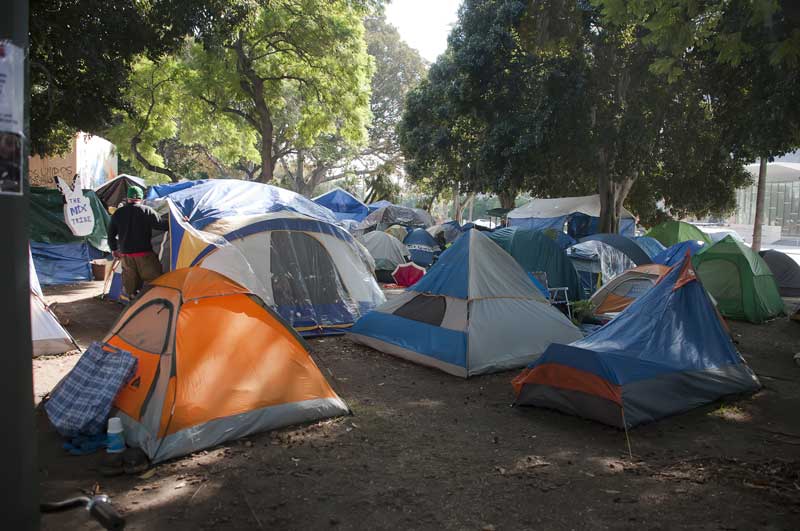
Designated Camping:
A Safer Solution
Introduction
More people than ever are experiencing unsheltered homelessness in America. According to annual point-in-time count data, the number of unsheltered individuals increased from 176,357 in 2016 to 233,832 in 2022.1 The Department of Housing and Urban Development estimates that 40 percent of those experiencing homelessness are living outdoors, and 61 percent of the chronically homeless are unsheltered. Despite the increases in chronic homelessness, unsheltered homelessness, and individuals experiencing homelessness, there has not been a significant increase in the number of temporary shelter beds to accommodate these people, in part because federal resources to address homelessness have prioritized longer-term permanent housing programs, leaving a much smaller portion of funding for shelter options that can move people off the street faster.
The misalignment of the growing unsheltered population with resources to offer them shelter has led to a worsening humanitarian crisis and widespread public dissatisfaction. A recent poll by the Cicero Institute found that 66 percent of Arizonans said that homeless encampments on city streets made them feel unsafe.2 A poll of Utah residents found that 62 percent of the public sees recovery and temporary shelter as a better response than tax-funded permanent housing.3
One cost-effective and quickly implementable solution to fill the gap between the unsheltered population and shelter capacity is called “designated camping.” Designated camps are monitored areas of public land where unsheltered individuals can move their tents, secure their belongings in lockers, access sanitary facilities and treatment services, and benefit from the security of law enforcement.
Misaligned Shelter Resources
Many U.S. cities have seen a spike in unsheltered homeless without an increase in temporary housing. This problem is, in part, the result of federal policies. Ten times more federal funding is available for permanent housing options than for temporary shelters. In part, due to the 9th Circuit Court of Appeals’ ruling in the Martin v. City of Boise case, many cities in the Western United States without sufficient shelter or shelter alternatives were unable to enforce their rules against street camping. That decision was vacated by the Unites States Supreme Court Decision in Johnson v. Grants Pass, Oregon.
The result is that cities have seen a dramatic increase in street encampments, many of which present public safety risks.
In Seattle/King County, there has been a 246 percent increase in unsheltered homeless between 2007 and 2022. Only 44 percent of homeless individuals currently without shelter in Seattle have a shelter bed available to them.4
The unsheltered homeless population increased by 58 percent between 2007 and 2022 in San Francisco, yet only 24 percent of homeless individuals have a bed available to them.5 There are zero empty beds, while 4,321 slept outside. Despite the rise in unsheltered homeless, temporary beds, which include emergency and transitional shelters, decreased by 26 percent, from 3,530 in 2020 to 2,606 in 2022.
Portland, Oregon, shares a similar story.6 Unsheltered homelessness increased by 20 percent between 2007 and 2022, yet only 57 percent of homeless individuals have a bed available to them. Further, only 52 percent of homeless families have a bed available to them. There are no available beds, and 453 homeless families are sleeping outside in Portland.
Public Safety Risks of Street Camps
The unsheltered homeless population has many serious challenges. The prevalence of crime, untreated mental health and substance abuse disorders, and incarceration among the homeless population is staggering. In Manhattan, one study found that, between a mentally ill housed person and a mentally ill homeless person, the latter is 35 times more likely to commit a crime and 40 times more likely to commit violent crimes, especially toward strangers. The San Diego County DA’s office found that homeless individuals were 514 times more likely to commit a crime than the average citizen. In 98 percent of cases, a homeless offender is a repeat offender.
Roughly half of people in homeless shelters have been to prison, with one in five having left within the last three years. A report from researchers at the University of California at San Francisco found in June 2023 that nearly one in three homeless people in California had been to prison or a long-term jail stay in the six months prior to becoming homeless.8 That same study found that more than 80 percent of people experiencing homelessness reported serious mental health conditions, for which one in four had been hospitalized. Two-thirds reported regularly using hard narcotics like methamphetamine, crack cocaine, and opiates, less than half of which reported ever receiving treatment. A mere four percent cited high housing costs as the primary reason they became homeless.
Predictably, crime around street encampments is disproportionately high. In 2022, roughly one in four homicides and 15 percent of all violent crimes in Los Angeles involved homeless individuals as either perpetrators or victims, or both, despite the homeless representing less than one percent of the population.9 In Vermont, a homeless encampment was cleared after an occupant fired a gun at a passing school bus full of children, shooting out its windshield.
Designated Camping
Designated camping offers an affordable, fast, and safe alternative to street camping while more temporary shelters can be constructed. The structure of designated campsites varies by location. Still, a practical guide for authorized encampments by the Seattle University School of Law concludes that all designated camping has four standard components: a community of unhoused people, present by permission of the landowner or local ordinance, on land owned by someone other than themselves, and with formal operating and governance structures.10
Designated camping provides a unique resolution to homelessness because many of the camps have security 24/7 to keep residents safe, sanitary stations that offer showers, toilets, soap, and other necessary amenities, as well as access to mental health and substance abuse treatment.
In addition, designated camping is a useful tool for cities to enforce ordinances against sleeping and camping in public spaces. By providing a designated camp for people to go, public spaces are preserved, health and sanitation issues are effectively addressed, and services can be specifically targeted to those in need.
In a survey of Utah residents, 68 percent said they support designated campsites for people experiencing homelessness.11 The city plans to start operations of its designated campsite by the end of 2023.
Designated Camping Successes
A new poll in Portland found that 69 percent of voters support a large designated encampment for the homeless and a ban on undesignated camping.12 In response, Portland has authorized large designated homeless camps called “Safe Rest Villages” that have served 345 people since opening, of which 33% were or are chronically homeless.13 Seventy people have exited the camp to transitional housing, and 169 identifying documents (identification cards, birth certificates, etc.) were obtained for the residents due to services from the camp. Inside the camp, residents can access food, laundry, and electricity. The original resolution involved the creation of the encampment as well as a public camping ban, but the ban failed to get the votes necessary from the city council.14
Denver, Colorado, currently has three designated camping areas for the homeless called “Safe Outdoor Spaces” (SOS), which housed 242 people and helped 47 transition into stable housing in 2022.15 The spaces are monitored 24/7, providing resources like showers, food, and access to programs and services. Despite overall crime in Denver increasing by 14 percent in 2021, crime in the designated SOS spaces decreased by nearly three percent.16 Police say no resident has been charged with a crime while living in one of the SOS sites.
In 2019, Austin, Texas, implemented the first designated encampment in Texas on land provided by the state.17 It is located on seven acres of asphalt near the airport. It started as a place where the homeless could pitch a tent but has evolved into a tiny home community for homeless individuals. Currently, 80 homes with services provided by The Other Ones Foundation (TOOF) are on a 10-year lease. TOOF plans to install 100 more homes in the area. On-site, residents have access to two meals daily, bathrooms, laundry, security, and case management. TOOF states it helped 170 residents find housing in 2022.
Seattle, Washington, has three designated camps available for homeless individuals.18 A 2017 evaluation found that they did not increase crime and that surrounding communities responded favorably to the camps.19 The camps offer 24-hour surveillance, and the residents are held to a set of rules they must obey. In 2016, the camps served 467 people; of those who left the encampment, 26 percent moved on to permanent housing, and 13 percent moved on to transitional housing.
Conclusion
Designated camps provide a safe space for homeless individuals to bring their camping equipment, pets, and partners. It is an area that is facilitated with security and services to ensure that the community within the camp and the surrounding area is safe. Homelessness does not have to be a life without dignity, and allowing camps that enforce rules while providing safety and stability is of paramount importance to this especially vulnerable cohort of people.

Stay Informed
Sign up to receive updates about our fight for policies at the state level that restore liberty through transparency and accountability in American governance.